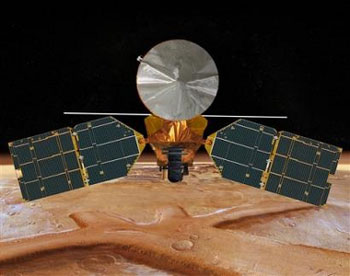|
NASA spacecraft enters orbit around Mars
(AP)
Updated: 2006-03-11 08:37
A NASA spacecraft successfully slipped into orbit around Mars Friday, joining a trio of orbiters already circling the Red Planet.

This artist's concept of the Mars Reconnaissance Orbiter released by NASA features the spacecraft's main bus facing down, toward the red planet. After a seven-month journey, a NASA spacecraft closed in on Mars on Friday March 10, 2006 on a mission to examine the Red Planet in unprecedented detail from low orbit. [AP] |
Scientists cheered after the Mars Reconnaissance Orbiter emerged from the planet's shadow and signaled to NASA's Jet Propulsion Laboratory that the maneuver was a success.
"Oh I am very relieved," project manager Jim Graf said minutes later. "It was picture perfect."
The two-ton spacecraft is the most sophisticated ever to arrive at Mars and is expected to gather more data on the Red Planet than all previous Martian missions combined.
It will explore Mars in low orbit for four years and is expected to churn out the most detailed information ever about the planet and its climate and landscape.
In the fall, the orbiter will begin exploring the Martian atmosphere, scan the surface for evidence of ancient water and scout for future landing sites to send robotic and possibly human explorers.
The $720 million mission is managed by JPL in Pasadena.
After a seven-month, 310 million-mile journey, the orbiter arrived at Mars Friday for the risky orbit insertion phase. Project managers had been nervous because of Mars' reputation of swallowing scientific probes.
But the Reconnaissance Orbiter performed the move without problem.
As it neared the planet, it fired its main propulsion engines for 27 minutes to slow itself down so that the planet's gravity could pull it into orbit. At one point during the burn, the spacecraft disappeared behind Mars — as engineers had planned — and was temporarily out of radio contact with controllers.
Mission control was visibly tense as it awaited word from the orbiter, which reappeared and signaled that it had entered into an elliptical orbit around Mars that will swing it as close as 250 miles above the surface.
The spacecraft will spend seven months dipping into the upper atmosphere to shrink the orbit.
The successful mission was welcome news for NASA, which has a mixed record of putting spacecraft into orbit around Mars.
In the last 15 years, NASA lost two orbiters back-to-back — the Mars Observer in 1993 and the Mars Climate Orbiter in 1999 — during the orbit insertion phase.
The Reconnaissance Orbiter is the fourth eye on the Martian sky, joining NASA's Mars Global Surveyor and Mars Odyssey and the European Space Agency's Mars Express, which have been mapping the planet the past few years. On the surface, the NASA rovers Spirit and Opportunity, continue their robotic geology missions.
The newest orbiter is loaded with the most advanced science instruments ever sent to another planet including a telescopic camera to photograph the surface in unprecedented detail and radar to probe underground for ice and possible evidence of liquid water.
The spacecraft won't beam back images or data until November. Like previous space probes before it, it will seek for evidence of ancient water and other signs that the planet could have been hospitable to life.
It will also scan for potential spots to land the next generation of robotic rovers and determine whether human outposts can survive on the dusty planet.
Present-day Mars is dry and cold with large caps of frozen water at its poles, but scientists believe the planet once was warmer and wetter eons ago — conditions that might have been suitable for life.
During the mission's second phase, the orbiter will transmit data between Earth and Mars. It is expected to serve as a communication relay for the Phoenix Mars Scout, which will explore the icy north pole in 2008 and the Mars Science Laboratory, an advanced rover scheduled to launch in 2009.
The Reconnaissance Orbiter's primary mission will end in 2010.
|